Grid soil testing is a method of evaluating soil conditions over a specific area by taking multiple samples at regular intervals. This method is an improvement over traditional transect line testing, which only takes a small number of samples along a single line.
The grid soil testing process begins by dividing the area to be tested into a grid of equal-sized squares or rectangles. A sample is then taken from each square or rectangle and analyzed for various properties such as pH, nutrient content, and soil health.
The benefits of grid soil testing over traditional transect line testing include:
- Greater accuracy: By taking multiple samples over a larger area, grid soil testing can provide a more accurate representation of the soil conditions within that area.
- Greater detail: Grid soil testing can reveal variations in soil conditions that may not be apparent when only taking a few samples along a transect line.
- Better planning: With detailed information about the soil conditions, farmers and landscapers can make more informed decisions about crop selection, fertilizer application, and irrigation.
- Cost-effective: Grid soil testing can save money in the long run by identifying problem areas and allowing for targeted solutions.
Overall, grid soil testing is a more efficient and effective method of evaluating soil conditions than traditional transect line testing. It provides a more detailed and accurate representation of soil conditions, which is useful for making informed decisions about crop selection, fertilizer application, and irrigation.


